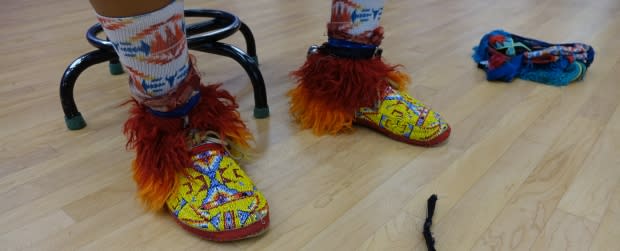Indigenous teen melds tradition, technology to 'dance in the rainbow'
It takes about 20 minutes for Theland Kicknosway's transformation from ordinary high school student to globe-trotting hoop dancer.
The 15-year-old Merivale High School student first began learning the traditional art form at the age of five. Since then, his talent has taken him across Canada, and to performances in Mexico and at the United Nations in Switzerland.
For Kicknosway, it's about storytelling through dance.
"It can be a warrior dance or a healing dance," he explained. "I try to create images I've seen ... butterflies or hawks or an eagle. There's a whole lot of different moves you can do with the hoops that help you portray your story."

Childhood dream
Traditionally, dancers used willow branches to make the hoops, which they would bend, tie and dye red. But Kicknosway wanted something different for his performances.
'Being able to share my story through this dance means showing people we're not gone.' - Theland Kicknosway
At age seven, he told his mom Elaine that he wanted to "dance in the rainbow." She promised to help him realize his dream.
Two years ago, she discovered glow-in-the-dark LED hoops for sale online. They soon arrived in the mail, and have now become Kicknosway's colourful trademark.
"It's amazing, just the images I can portray with these modern materials, the LEDs. They show something different that you might not be able to see with the traditional red willow hoops. The modern and traditional, and both of them colliding — it makes an impact. People haven't seen this style of hoop dancing before."
Kicknosway now picks up his hoops to practise about once a day. For performances, he dons traditional garments that accentuate the movement of his arms and legs.

Bringing back the dance
Kicknosway is motivated by his urge to revive this Indigenous tradition, which he says was forced underground in the 19th century.
"The government tried to push these dances away. They weren't allowing us to come together and share and practise or own style of communication. I'm just happy that I'm able to bring this dance back from when it was almost extinct."
Kicknosway's mother is a Sixties Scoop survivor and his father was a patient at a so-called 'Indian Hospital' — government-run health institutions now facing allegations of widespread mistreatment and abuse.
"Being able to share my story through this dance means showing people we're not gone," Kicknosway said. "Us as youth, we're leading the way, we're rising up and we're sharing our culture with everyone so they can pass it on to future generations. It makes me feel proud as an Indigenous youth to pass on the torch."

